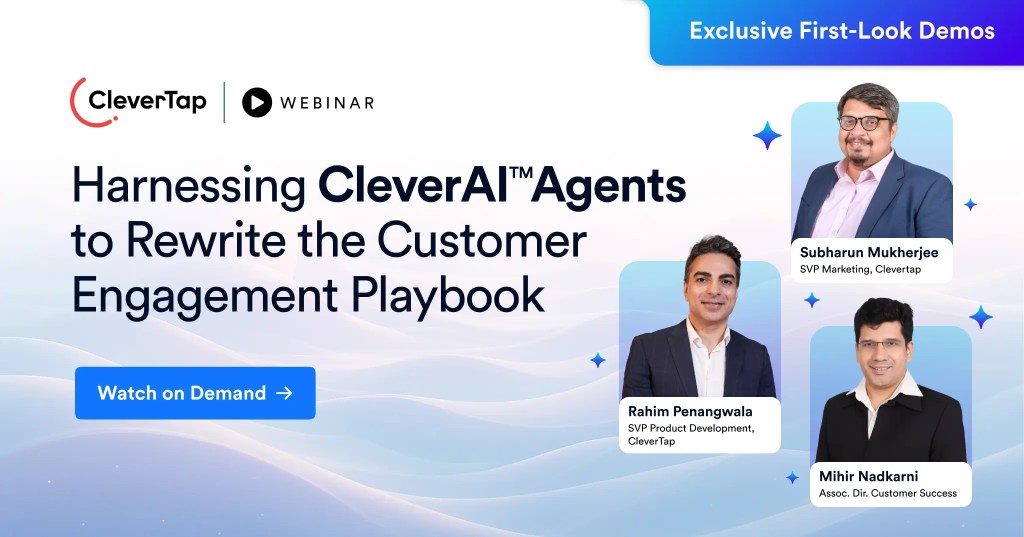In the competitive landscape of mobile apps, simply creating a great product isn’t enough—effective user acquisition strategies are essential for success. With millions of apps vying for attention and the majority of smartphone users downloading only a couple each month, standing out from the crowd is no easy feat.
In this comprehensive guide, we explore the diverse array of acquisition channels available to mobile app developers, providing insights into successful strategies employed by top apps and evaluating the pros and cons of each approach. Additionally, seasoned growth marketers share expert advice on acquiring users for your app, ensuring you have the tools and knowledge needed to make an impact in the mobile market but first, we will understand what exactly is mobile user acquisition and its importance.
What is Mobile User Acquisition?
Mobile user acquisition refers to the process of acquiring new users for a mobile application or service. It involves various strategies and techniques aimed at attracting individuals to download and install an app, ultimately converting them into active users.
Why is User Acquisition Important?
In today’s competitive landscape, businesses face a daunting challenge: standing out amidst a sea of apps and convincing users to install theirs. User acquisition isn’t just about attracting attention; it’s a data-driven science that identifies trends and patterns, eliminating guesswork and optimizing ad spend.
Without a strategic approach to user acquisition, businesses risk getting lost in the noise and missing out on valuable opportunities for growth. By harnessing data and insights, businesses can not only boost app discovery but also convert users more effectively, ensuring their app’s success in an increasingly crowded marketplace.
Mobile User Acquisition Strategies
1. App Store Optimization (ASO)
App stores are still the #1 driver of app discovery. According to data by Statista,* approximately 561 million apps are downloaded from app stores every single day.
App store optimization is the practice of attracting users to download an app based on the title, keywords, ratings, and other ranking factors. Done right, ASO can drive a huge amount of high-quality traffic to your app.
- Focus on key page elements. Including top keywords in the title tag, featuring a mix of eye-catching screenshots, creating a recognizable app icon, and writing an engaging app description can boost your visibility significantly within App Store rankings.
- Localize app store pages for each target market, including search keywords. Only 31% of app revenue is generated by North American consumers, and localized search keywords and welcome pages can result in up to 767% more downloads.*
- Optimize for both search discoverability and conversions. By A/B testing page elements, you can find out what works best to entice visitors to download and launch your app.
Check out our in-depth collection of App Store optimization best practices for more tips.
CON: Takes time and testing to find a winning approach
ASO Example: Dark Sky Weather
When Dark Sky Weather changed their title from simply “Dark Sky” to “Dark Sky – Weather Radar, Hyperlocal Forecasts, and Storm Alerts”, their rankings skyrocketed. Including the right keywords in your title has a tremendous impact. 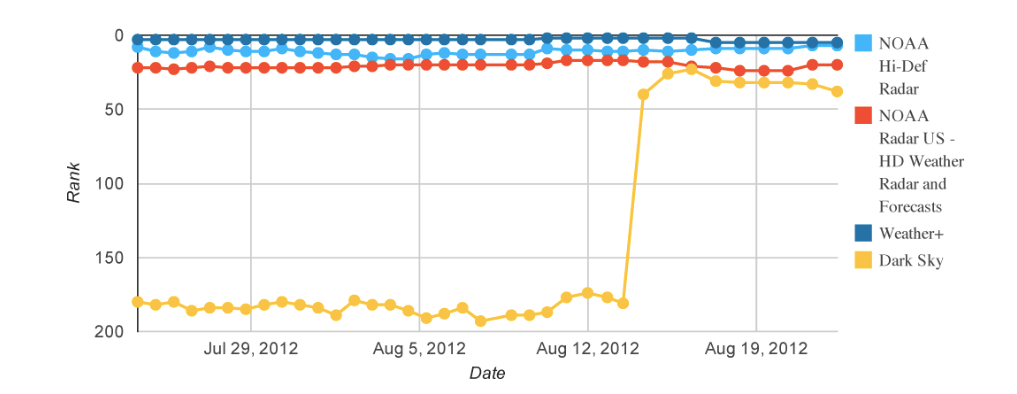
App Store Search for “Weather” Image: Dark Sky
Their current app store page is packed with keywords like weather, forecasts, radar, hyperlocal, and weather alerts. It features beautiful screenshots, a description that highlights the app’s key benefits, high user ratings, and even an Editor’s Choice award.
The app is currently ranked #1 in the Weather category and ranked in the Top 50 overall.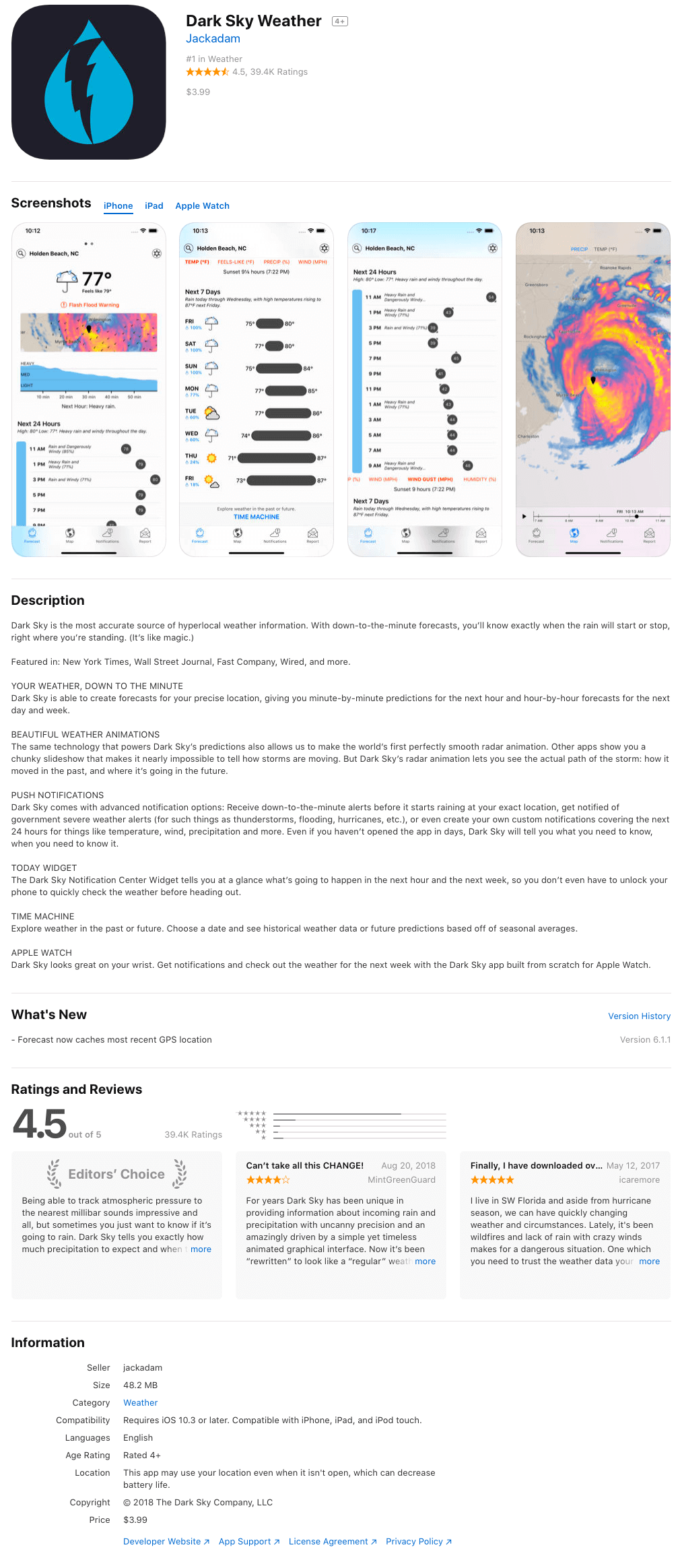
Dark Sky on the Apple App Store
2. Organic Mobile User Acquisition
Organic channels can be both an effective and cost-efficient way to drive app user acquisition. Building a website, maintaining active social media channels, and funneling traffic to your app store page are all tactics that drive organic growth.
Organic campaigns are especially effective when complemented with paid ads, which can boost organic app installs by 150%.* Which only proves the importance of diversifying your user acquisition efforts over several channels and strategies.
- Use smart banners to take users from your mobile website to the mobile app. Include deep links to take visitors straight to a page within the app, or directly to your app store page to install.
- Do content marketing. Create blog posts, infographics, videos, and ebooks around topics your customers are interested in and searching for. Don’t just create content for the sake of filling an empty blog — ensure that every single piece of content is high quality and provides unique value for readers.
- Target the right traffic. Don’t neglect quality for the sake of quantity. Create marketing personas that include details like age, gender, income, educational background, location, job title, and interests to focus your efforts on the right audience.
CON: A long-term mobile app user acquisition strategy that takes time to see cumulative benefits
Organic Mobile User Acquisition Example: Evernote
Since their inception in 2007, Evernote has focused on education and content marketing as a basis for its mobile user acquisition strategy. Fast forward to today, and the app has over 225 million users and a reported valuation of $1 billion.
Evernote’s content campaigns feature articles and videos on topics like productivity, goal setting, going paperless, app usage tips, and even interviews with high-profile users. Its content is both educational and engaging, and designed to appeal to both current Evernote users and potential users whose pain points the app solves. 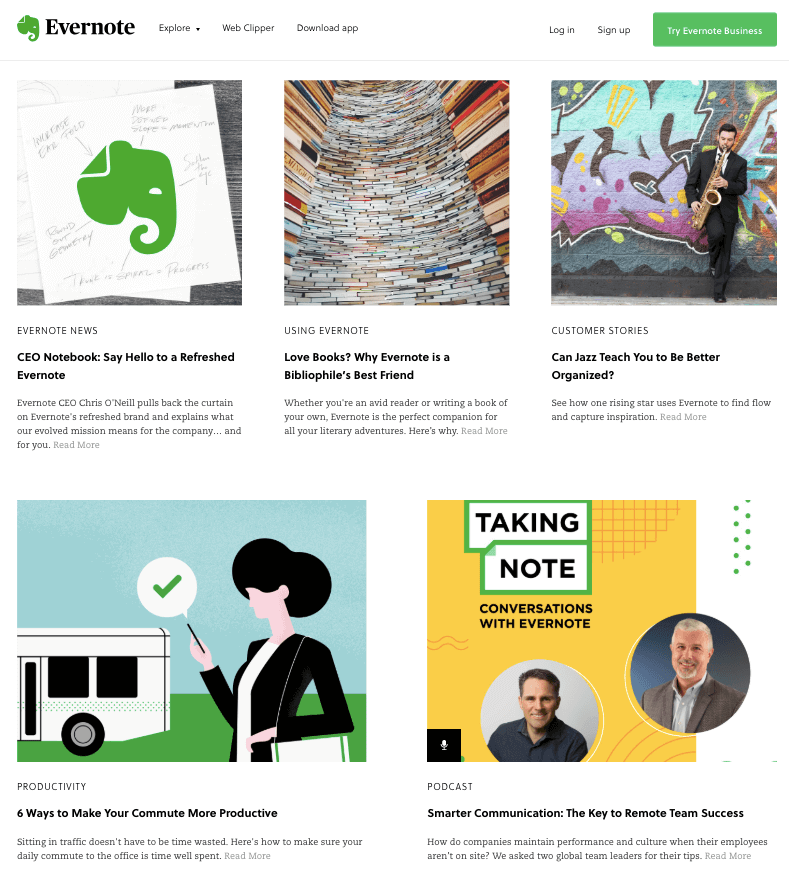
Image: Evernote Blog
3. Paid Advertising
Paid ads can put your app in front of a massive audience, not to mention create additional touch points to further engage existing users. Think social media ads, PPC campaigns via Google Adwords, native and interstitial ads, even cross-promotions with partner apps.
- Tailor ads for different funnel stages. By creating different ads and CTAs, you can target potential users at each stage of the process to nurture them from awareness to downloading or purchasing your app.
- Use audience targeting to create more personalized ads based on demographics, interests, and behaviors, as well as device type. Just don’t get so specific that your audience is too small. (For example, Facebook recommends a target audience of at least 100k.)
- Create a series of mobile app landing pages that are designed to convert visitors who click on your ads. Describe your app’s features and value proposition so that visitors are enticed to click through, download, and launch your app.
CON: Can be expensive
Paid Ads Examples: Hopper
Flight tracking and travel booking app Hopper used Instagram Stories to reach 7.5 million millennials across the US and Canada. It used campaign targeting to zero in on young people who plan their trips further in advance and are interested in monitoring fares over the course of a few months in order to nab the best price.
The results? A 67% higher rate of app installs, 50% more flight searches for new users, and an 80% higher booking rate for new users.*
As of October 2018, Hopper has passed 30 million installs. It’s on track to make nearly $1 billion in sales this year, in addition to a $780 million valuation. 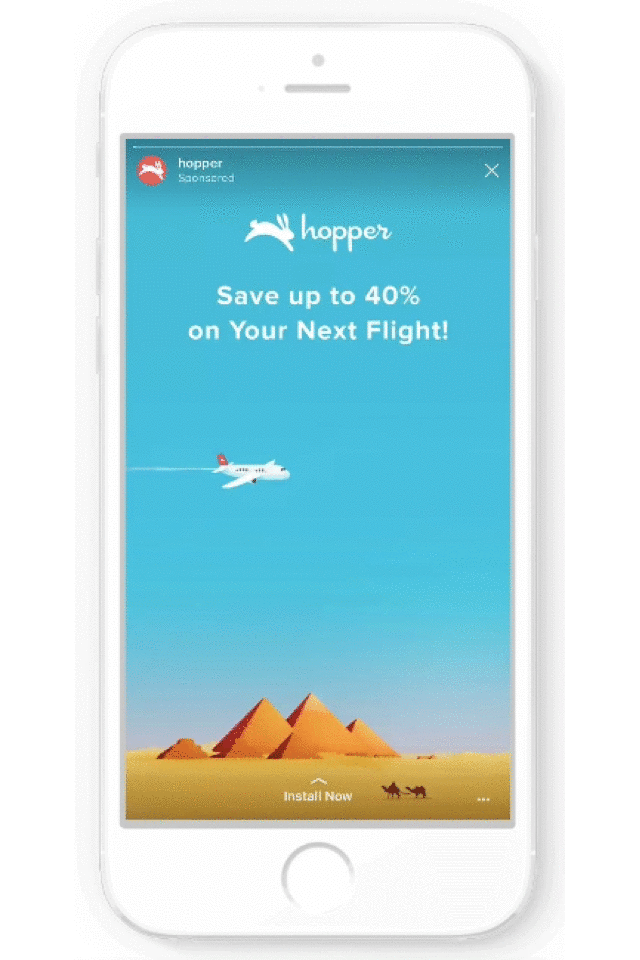
Image: Instagram Business
4. Influencer Marketing
Winning your audience’s trust and gaining a following can be incredibly difficult, especially when you’re just entering the market. By tapping into an influencer who already has an established relationship with your target users, you can increase your credibility and brand awareness in a huge way.
In fact, 33% of users say they downloaded an app because it was recommended to them.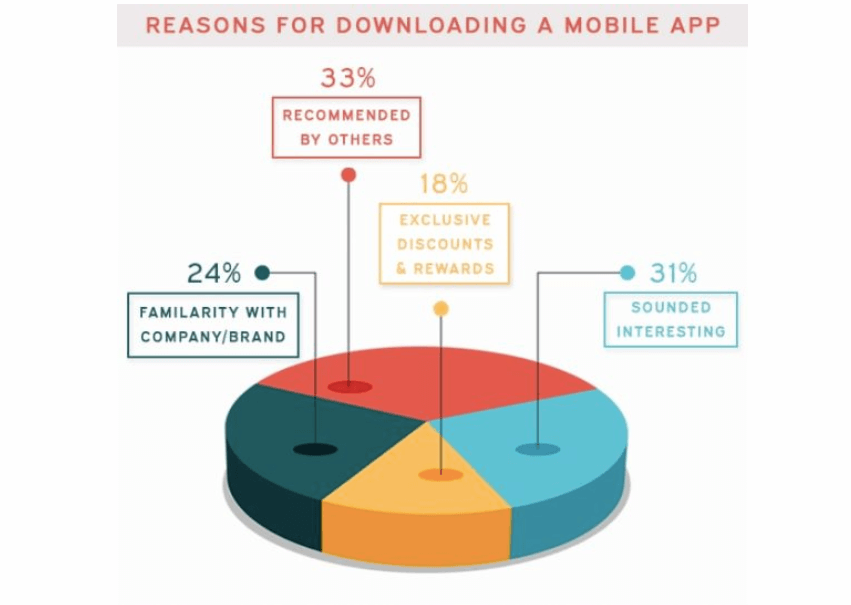
Image: Promatics
- Choose influencers carefully. As extensions of your brand, think of influencer marketing as a full partnership. While you need to be selective, you should also allow influencers creative freedom to represent you in a way that also fits their brand and audience.
- Pick the right platform. Facebook or YouTube? Instagram celebrity or popular blogger? When choosing a platform, consider where your target audience spends their time.
- Focus on storytelling. Work with the influencer to tell the story of how your app fits into their lives and impacts the things they (and their audience) care about.
CON: Can be difficult and time-consuming to find and partner with the right influencers
Influencer Marketing Example: Headspace
Starting in 2012, wildly popular meditation app Headspace grew its user acquisition by targeting a more mainstream audience: promoting mindfulness as a way to improve athletic performance.
They partnered with influencers from a variety of fitness communities, like running expert Knox Robinson and Paul Karmiryan of So You Think You Can Dance. And recently, the app inked a major deal with the NBA, where players with massive social followings will share how they incorporate the app into their training regimens.
5. PR & Press Coverage
Partnerships, journalists, bloggers, and even websites like Product Hunt can be extremely valuable channels to drive user installs. build app awareness, and generate buzz in the days and weeks prior to launch.
- Tailor your PR pitches. Before you reach out to journalists and bloggers, find out how your app fits into what they write about and what their audience is interested in. A unique angle will help your pitch (and your app) stand out.
- Target early adopters. Which media outlets are most likely to get excited about your app and generate enthusiasm for the launch? Identify reporters and media outlets that can reach early adopters and create some word-of-mouth buzz for your app.
- Build a media kit. Go beyond a simple press release by creating a media kit with more information that bloggers and journalists can use to learn about your app. Explain who you are, what prompted you to create your app, and detail any past success with app development. Share stats about the number of downloads, app rankings, and size of your user base. And include screenshots of your app’s UI.
CON: Time-consuming
Press Promotion Example: Mint
Mint founder Aaron Patzer concentrated on PR from the start, spending a full week every 2 months on press tours. By the time of acquisition, Patzer had completed about 550 interviews, with every outlet from ABC to Yahoo!. He credits those campaigns as their most effective user acquisition channels.
Mint’s PR efforts led to a 255% increase in coverage and extremely high-quality traffic. They saw as many as 20,000 signups a day and became the fastest-growing personal finance software. According to Patzer, their PR campaigns were so efficient that Mint’s cost of user acquisition was under $1.*
Image: Mint
6. Digital Video
71% of mobile marketers say they use video for user acquisition.* Why?
Is it because YouTube now reaches more individuals between the ages of 18-34 than any cable network?*
Perhaps because 30-second mobile video ads have an 88.3% completion rate?*
Because videos see 1,200% more social media shares — and bring visitors to your site that have a 64% likelihood of converting?
Or maybe because new users acquired via video ads have 3x higher retention rates than users who find an app via non-video ads?
- Consider rewarded videos. Viewers can choose to watch them in exchange for extra streaming time, lives, or virtual currency. 80% of users opt-in to rewarded ads, with 90% customer loyalty and engagement rates.*
- Include video on your mobile landing pages to improve conversions by up to 80%.*
- Feature user-generated content in video ads. 85% of consumers say user-generated content is more influential than brand-generated videos.* Plus, viewers will learn what the app looks like, watch key features in action, and see the app’s value firsthand.
CON: Can be difficult to measure effectiveness
Digital Video Example: Netflix
Original programming is the foundation of Netflix’s business, for both user acquisition and retention. 58% of subscribers say they pay for Netflix for its original shows.* And the investment is paying off — the streaming giant added nearly 7 million users in the third quarter of 2018 alone.
Building awareness and excitement around its original programming premieres is critical, and Netflix takes a multi-channel approach that spans social media, video, print, and TV. To promote Season 3 of Stranger Things, for instance, Netflix released a video ad that teases a return to Hawkins, Indiana. The ad has nearly 2 million views and almost 5,000 viewer comments.
7. Email Marketing
With up to 70% of emails now opened on mobile, there is a huge opportunity to drive customers and prospects to your app.
Use email marketing strategies to promote your brand’s content, share product updates, offer discounts, and hype upcoming events. Email is also a great way to connect with your audience in a more personal way, whether it’s a happy birthday email, a custom offer, or a personalized content recommendation.
- Optimize for mobile. Everything from copy to column layouts and CTA buttons need to be optimized for mobile screens. Check out our How to Create Mobile-Friendly Emails infographic for the ideal subject line length, CTA placement, and more.
- Use email to request feedback. Ask recipients to reply to emails! Find out how you can improve your app and learn more about what your target audience wants from you.
- Use deep links within emails to take users directly to a specific page within your app (think product pages or shopping carts with a promo code pre-applied) or to your app store listing to install.
CON: Requires continual testing and optimization
Email Marketing Example: Uber
Uber is recognized as one of the fastest growing mobile apps, increasing their user base by 443% over just three years. 75 million riders take 15 million rides every day, and 21% of all US Android devices have Uber installed.*
Uber as a brand is defined by simplicity: just tap a button and get a ride anywhere you want to go. That simplicity is reflected in its user acquisition emails, with a simple color scheme, single call-to-action, and straightforward copy.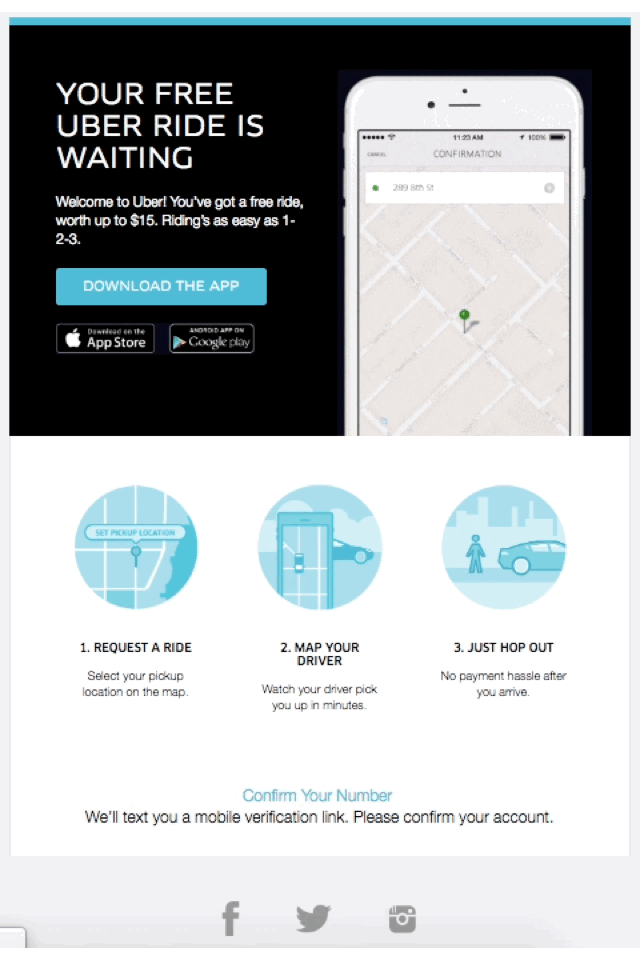
8. Referrals & Invites
According to a Nielsen study, 92% of people trust referrals from friends.*
A referral program can add a viral component to your user acquisition model and lower your customer acquisition costs. They not only provide incentives for users to share your app with their networks, they introduce your app to potential users in a way that builds trust.
- Go beyond cash back rewards. Try offering free products and services, discounts, or access to exclusive content or features.
- Make referral codes easy to share. Use in-app messaging to prompt active users to invite friends, and include social sharing buttons in your app.
- Encourage bragging. Make it easy for users to share achievements, badges, photos, location check-ins, and user-generated content to their social media networks along with their referral code.
CON: Referrals can lose their impact if people know the person recommending the app is getting a reward.
Referrals & Invites Example: Airbnb
Airbnb is a hallmark example of using referrals and social proof to fuel exponential growth. After conducting some internal research, Airbnb discovered that 25-55% of new user growth could be produced through referrals.
But instead of trying to get users to send as many invitations as possible, they focused on figuring out which contacts users were closest to and sent customized emails that featured the referrer’s profile photo. As Growth Product Manager Gustaf Alströmer explains, “It was important that each invite appear as a gift, not a promotion.”
The results? Customers gained through referral programs booked more reservations, became hosts more often, and even referred more users. Overall, referrals increased bookings by over 25% in some markets.
Airbnb now hosts 150 million guests across 191 different countries.*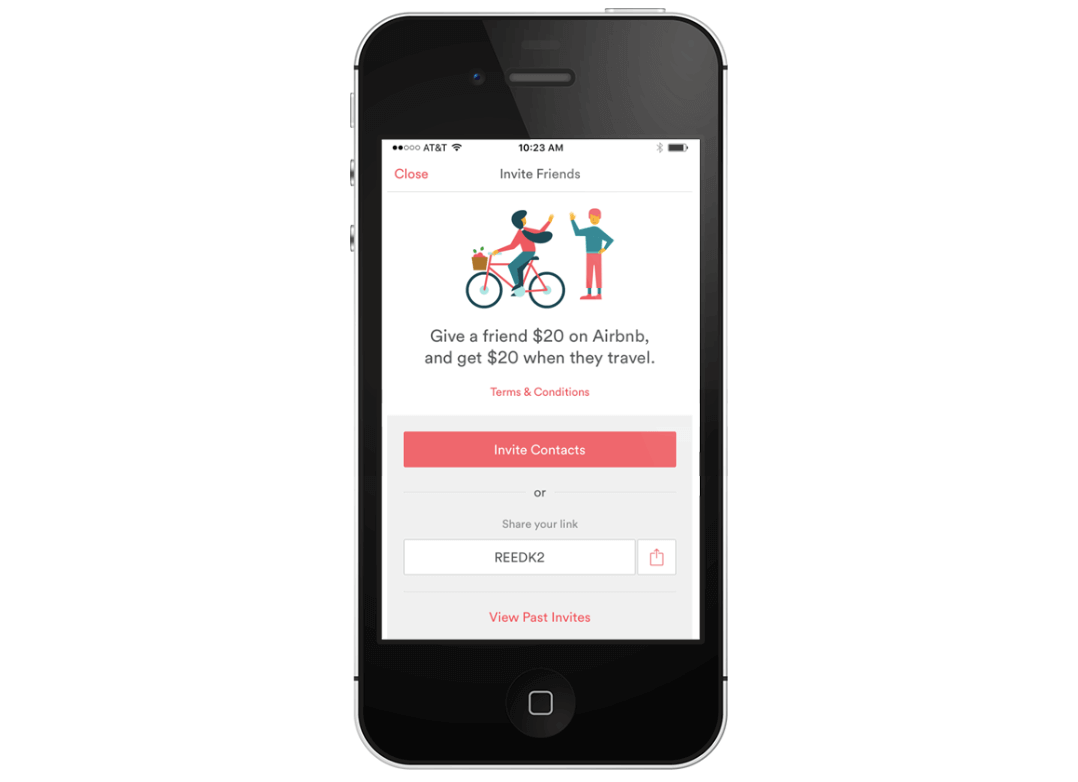
Image: Airbnb
9. Traditional Marketing Techniques
You may think traditional marketing techniques like TV, radio, and print ads are out of date in the era of all things digital. But don’t be too quick to discount them — TV spots can increase app installs by 56-74%.*
84% of TV viewers watch with their mobile device in hand or within arm’s reach,* even scrolling through them during commercials. It’s an ideal moment to capture their attention and persuade them to check out your app.
- Follow up with retargeting campaigns. Retarget potential new users with mobile ads during the two-hour window after your TV ad to prompt more installs.
- Be strategic with audience targeting. TV and print consumers tend to be selective about the content they watch or read, which can make it easier for marketers to target niche audiences.
- Measure traditional marketing initiatives like any other channel. Set attribution windows for specific times and cities, corresponding with where and when your ad airs. Compare the average number of organic installs in the few weeks prior to the ad airing, then contrast with the results during your airing window.
CON: Expensive. According to Adexchanger, minimum spend is often $100,000.*
Traditional Marketing Examples: Clash of Clans and Game of War TV Ads
Liam Neeson’s Clash of Clans commercial was the most-viewed ad of the 2015 Superbowl on YouTube with more than 30 million views. And the app’s $9 million ad investment paid off: The mobile game jumped from #39 on the most-downloaded App Store charts to #24.
Similarly, Game of War‘s Kate Upton commercial sent the app shooting up 95 spots on the top-downloaded free iOS apps chart* and netted the game an estimated daily revenue of more than $1 million.*
10. Demos and Free Trials
What better way to convince users to download and use your app than letting them see its value firsthand? If you have a paid app or subscription service, let users demo your app on their phones for free before paying for it.
Highlight key features during the trial period and notify users which features will no longer be available once their trial ends. Show personalized in-app messages near the end of their trial notifying them that their most-used features will soon go away unless they subscribe or purchase the app.
CON: Free users can be lower-quality leads
Demo & Free Trial Example: 7 Minute Workout
App developer Stuart Hall built a simple 7 Minute Workout app in a matter of hours, then launched it as a paid app.
After doing some basic marketing and press campaigns, he decided to experiment with offering the app for free. The difference was staggering: 216,718 downloads in 3 days. That’s an average of 72,000 per day, which Hall says was up from an average of 28 per day at paid.
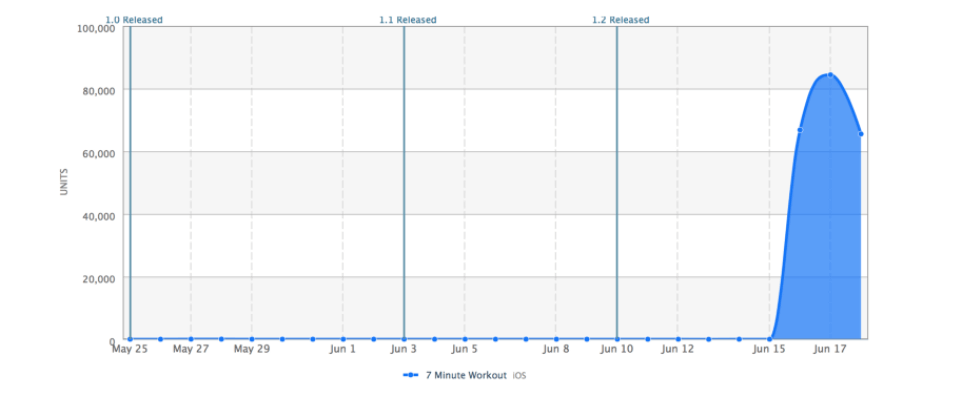 Image: Stuart Hall
Image: Stuart Hall
7 Minute Workout was the #1 fitness iPad app in 68 countries and the #1 fitness iPhone app in 49 countries.* Hall later monetized with a variety of in-app purchases and sold the app for over $70k profit.
How to Find the Right Mobile User Acquisition Channels
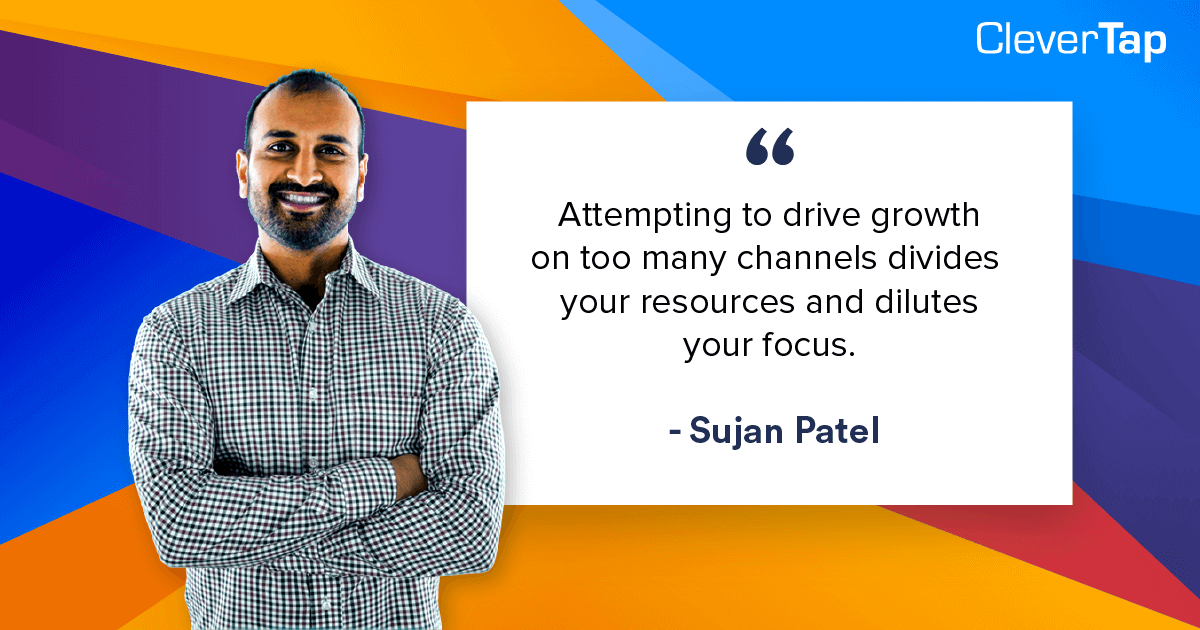
When it comes to acquiring new users, you can’t afford to just throw stuff at the wall and see what sticks. You have to analyze and choose your customer acquisition channels carefully.
So how do you do that without relying on your gut — or simply following what worked for someone else?
Brian Balfour’s Channel Matrix Method
Growth expert Brian Balfour uses a matrix to compare marketing acquisition channels.* The process starts with three basic steps:
Step 1. Create a spreadsheet and list out all potential channels in the header column. If you want to get detailed, you can break down certain channels into individual tactics. For example, content could include blog posts, infographics, ebooks, guest blogging, etc.
Step 2. List channel attributes in the header row. These include things like cost, input time, output time, control, scale, and audience targeting.
Step 3. Fill in each channel’s values as low, medium, or high.
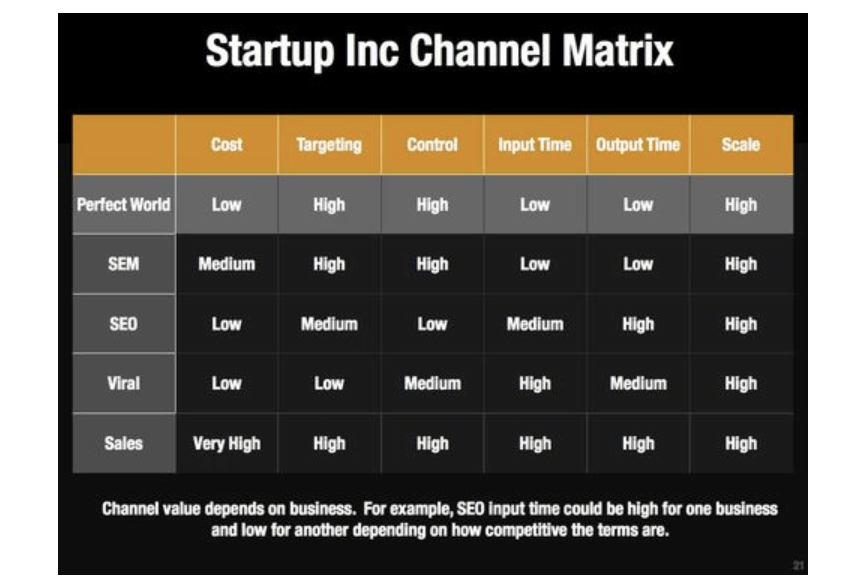 Image: Brian Balfour
Image: Brian Balfour
You can then choose channels that fit your business’ needs and goals.
Balfour notes that in a perfect world, you would want a channel that has high targeting, control, and scale, and low cost and time. But if your business is running on a tight budget, you can prioritize channels that have low cost and evaluate the other attributes to find the best fit.
Once you’ve narrowed in on a short list of channels, you can test viability in order to either optimize, or move on to test other channels.
Ryan J. Farley’s Tips for Choosing an Acquisition Channel
Growth marketer Ryan J. Farley recommends basing your acquisition channels on your Customer Lifetime Value. Since you can’t afford to spend more than you’ll make, your LTV can help eliminate ineffective marketing acquisition channels and focus your efforts.
Ideally, he says, you should plan to make 3 times what you spend on a customer within 6 months.
Farley also emphasizes the importance of testing and iteration. As with most things, your first attempt at cracking an acquisition channel might not be a complete success. That doesn’t mean you should write off the channel completely.
If you’re within what Farley calls “striking range” of making the channel work, it’s worth testing and iterating to see if you can crack the code.
His #1 piece of advice? “Think about how your customers buy, and plan your customer acquisition strategy accordingly.”*
Next Steps: Gauge Success with User Acquisition Metrics
So how will you know if your mobile acquisition efforts are paying off? Here are three key user acquisition metrics to track:
- New Downloads – # of new downloads (daily, weekly, or monthly).
- Download Attribution – Which channels are new users coming from? Use this data to optimize marketing spend and improve ROI / CLTV.
- Cost Per Install – Total Ad Spend / # of New Installs Counted by Advertiser’s Server
From Acquisition to Retention
An effective user acquisition strategy is essential to growing your mobile app. But it isn’t the end of the story.
Acquiring new users isn’t enough if they only use your app a few times before uninstalling. With the cost of acquisition, you simply can’t afford to lose your hard-won new users.
But with a solid retention rate, revenue compounds with time. The longer you keep users the more valuable they are to your business.
Learn everything you need to know about creating a practical and effective user retention strategy in this free download: Preventing Mobile App Churn.
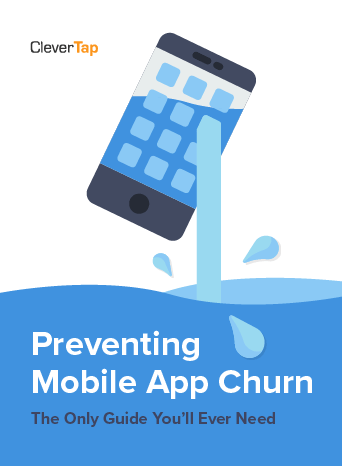
Preventing Mobile App Churn
Shivkumar M 
Head Product Launches, Adoption, & Evangelism.Expert in cross channel marketing strategies & platforms.
Free Customer Engagement Guides
Join our newsletter for actionable tips and proven strategies to grow your business and engage your customers.












































